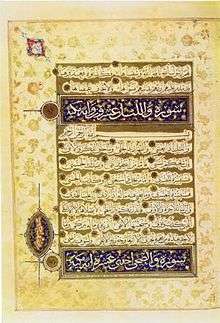Yaqut al-Musta'simi
| Yaqut al-Musta'simi | |
|---|---|
 | |
| Died | 1298 |
| Known for | Islamic calligraphy |
| Movement | Naskh (script) Thuluth |
| Patron(s) | Al-Musta'sim |
Yaqut al-Musta'simi (also Yakut-i Musta'simi) (died 1298[1]) was a well-known calligrapher[2][3] and secretary of the last Abbasid caliph. He was born of Greek origin in Amaseia and carried off when he was very young.[4] He codified six basic calligraphic styles of the Arabic script.[5] Naskh script was said to have been revealed and taught to the scribe in a vision. He developed Yakuti, a handwriting named after him, described as a thuluth of "a particularly elegant and beautiful type."[1] Supposedly he had copied the Qur'an more than a thousand times.[6]
Gallery
 Thuluth script, 13th century
Thuluth script, 13th century
References
- 1 2 Efendi, Cafer; Howard Crane (1987). Risāle-i miʻmāriyye: an early-seventeenth-century Ottoman treatise on architecture: facsimile with translation and notes. Brill. p. 36. ISBN 978-90-04-07846-8. Retrieved 26 July 2010.
- ↑ Dankoff, Robert (2004). An Ottoman mentality: the world of Evliya Çelebi. Brill. p. 42. ISBN 978-90-04-13715-8.
- ↑ Çelebi, Evli̇ya; Robert Dankoff (2006). Evliya Çelebi in Bitlis: the relevant section of the Seyahatname. Brill. p. 285. ISBN 978-90-04-09242-6. Retrieved 26 July 2010.
- ↑ Houtsma, M. Th (1987). E.J. Brill's First Encyclopaedia of Islam 1913-1936, Volume 1. BRILL. p. 1154. ISBN 9789004082656.
YAKUT al-MUSTA'SIMI, Djamal al-DIn Auu 'l-Madjd ... some say he was a Greek from Amasia; he was probably carried off on a razzia while still very young. He was a eunuch.
- ↑ Sözen, Metin; İlhan Akşit (1987). The evolution of Turkish art and architecture. Haşet Kitabevi.
- ↑ Knappert, Jan (2005). Swahili culture, Book 2. E. Mellen Press. ISBN 978-0-7734-6109-3.
This article is issued from Wikipedia - version of the 10/13/2016. The text is available under the Creative Commons Attribution/Share Alike but additional terms may apply for the media files.